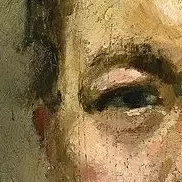In the 1940s Rothko, together with his friend Adolph Gottlieb, believed that the painting of myth, with allusions to tragedy, was the proper response to the horrors of war, the Holocaust and the atom bomb. He once wrote, with Friedrich Nietzsche in mind, that ‘only that subject matter is valid which is timeless and tragic’. His intention was to render this not as allegorical device, nor by narrating a Greek myth, but through abstract, allusive and thus more universal forms. The blue and burnt sienna ‘figure’, the grey ground and the yellow circle capped by flames correspond to the four elements of earth, water, air and fire. The bright red may be sacrificial blood.
https://dailyrothko.tumblr.com/post/152388059736/sacrifice-april-1946-watercolor-gouache-and
During the late 1930s and early 1940s Mark Rothko, like William Baziotes, Adolph Gottlieb, and Theodoros Stamos, combined mythical themes with primordial imagery in order to express universal experiences. In his work of this period evanescent biomorphic shapes float within an atmospheric haze. Resembling rudimentary life forms or primitive subaquatic plants and creatures, these shapes are intended to provide a visible equivalent of images lodged in the subconscious. Though he drew primarily on his innermost sensations, Rothko also looked toward earlier art. The example of Joan Miró is here evoked in the dotted line, the flame, the amorphic personage at the lower left, and in the meandering threadlike tendrils. Overtly representational images have disappeared, signaling a move toward the complete abstraction of Rothko’s mature style. In its horizontal zoning, cloudlike texture, and blurred contours, Sacrifice anticipates his characteristic, fully evolved Color-Field paintings.


My apologies. As kinttach pointed out, I had the wrong description. I have made the adjustment.